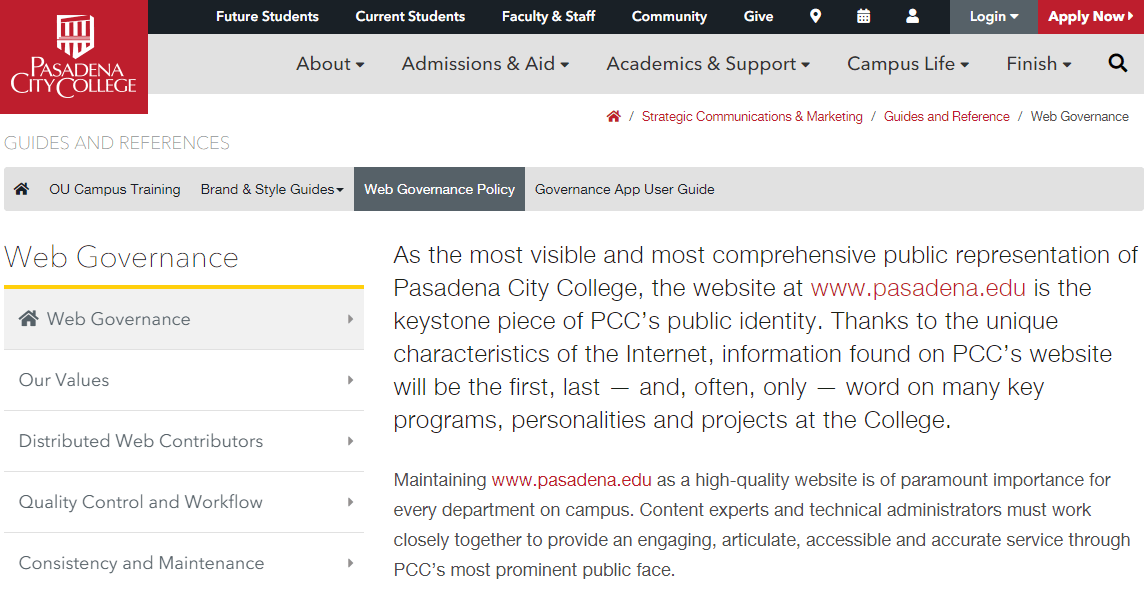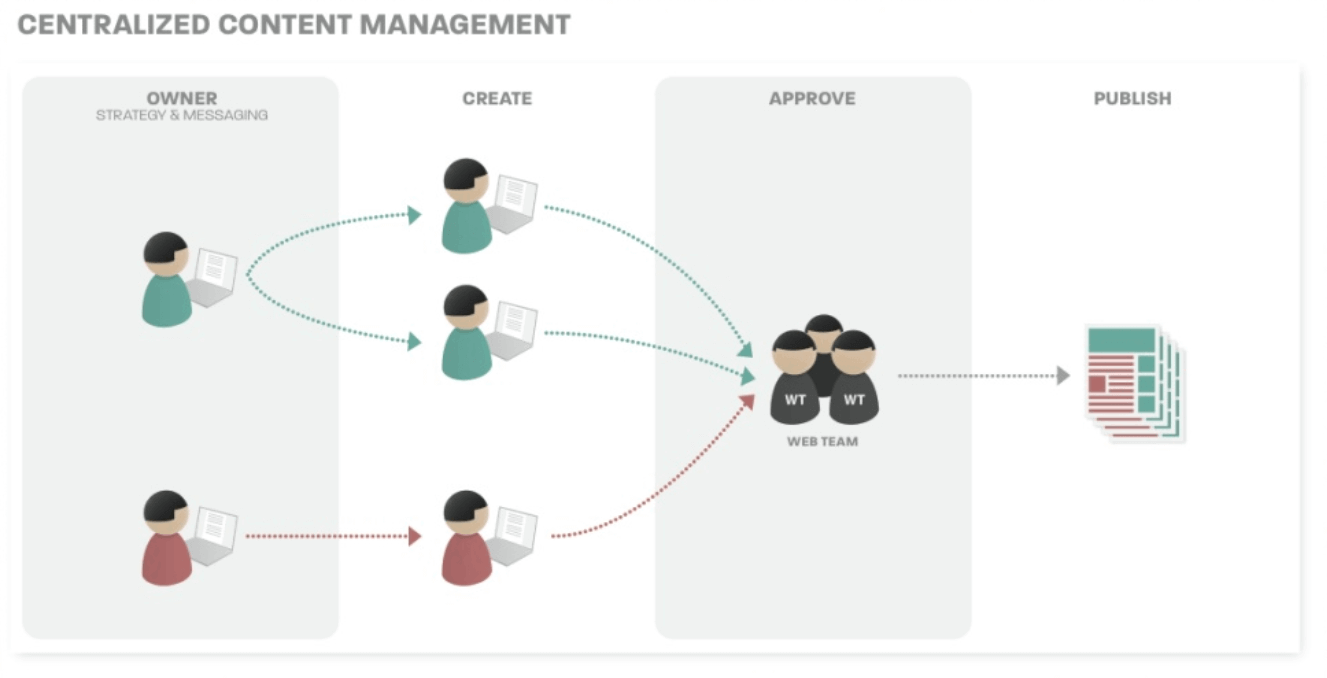Higher Ed Web Governance Best Practices: 6 Tips for Colleges
If you’re like most website managers, the daily upkeep of your website requires so
much attention that creating processes and procedures for how your site should be
managed keeps getting pushed to the bottom of your to-do list. But web governance
should not be an afterthought—and when it’s done right, it can actually enhance your
workflow and make your job easier.
To get started, you’ll need to:
- Understand website governance and why it matters.
- Consider strategies for website governance.
- Apply website governance best practices.
- Understand how a content management system can enhance your governance.
Making a conscious effort to be consistent and clear with your web governance policies will go a long way in maintaining the integrity of your college or university’s website.
The Complete Guide to Digital Accessiblity for Colleges and Universities
College and university website governance: Why does it matter?
Web governance is a broad term referring to how a website is maintained and managed by people, processes, and policies. In the early days of the internet, colleges and universities were hungry for content, so they allowed almost anyone to post almost anything. Furthermore, there was usually no centralized office to oversee the website. This led to bloated pages, stray PDFs, disorganized navigation, and outdated and irrelevant content—a veritable spider web of information and management with no rhyme or reason that some schools are still grappling with.
In recent years, website developers and administrators have called for a more consolidated, consistent approach to website governance. Rather than every department doing its own thing, one governing office dictates the order and operations of the website—or its framework. Website managers then work within the specified framework of governance to complete tasks such as content creation.
A well-structured website governance framework will answer these questions:
What actions are required for college or university website governance?
This is a comprehensive process that includes everything required to successfully govern a website. Your first step will be assessing and documenting what your college or university has in place in terms of web governance. Next, you’ll compile a detailed plan outlining your website goals and who does what. Monitoring and enforcing compliance follow, along with consistent evaluation and possibly revising the plan as needed. You’ll also want to post your plan so that as many people as possible can use it for reference. For example, Pasadena City College Guides and References page on their website is all-encompassing, showing how governance decisions were made and what processes should be followed.

Pasadena City College has a comprehensive web governance page on their website.
Image courtesy of Pasadena City College.
What are the benefits of enforcing proper governance?
Consolidated web governance standardizes policies and systems to help your college or university run smoothly. Such efficiency reduces confusion and maintains brand consistency.
What are the potential consequences of not having a web governance process in place?
Delaying establishing a college or university web governance process can jeopardize your institution’s functionality, organization, and even security. Likewise, as your school grows, responsibility must be clearly defined and assigned. Website governance is the only way you can ensure that your goals, messaging, and brand are cohesive.

There are numerous disadvantages to not having a web governance structure in place for your website.
Image courtesy of VisionPoint Marketing.How do I create a website governance strategy for my higher ed institution?
Website governance is a time-intensive process that requires buy-in from administration. With executive support, you can move on to the 5 Rs of web governance as defined by VisionPoint Marketing:
- Roles – Anyone involved in web operations should have a specific role in your web governance process.
- Responsibilities – Each role should have defined responsibilities so that everyone knows who is in charge of what.
- Relationships – How do these roles interact with each other, and what is the hierarchy? What are the checks and balances to maintain system efficiency?
- Rules – Does each area of the website such as content, branding, and procedures have written instructions that can be disseminated so that all can use them?
- Review – Who is going to be accountable and in control of final changes?
What are web governance best practices?
In the race to have content fresh and relevant on a sometimes minute-by-minute basis, it is important that your entire team has clearly defined roles and a documented process for publishing. At its most fundamental level, this type of workflow includes a contributor (or editor) and a reviewer/publisher. Sometimes these roles merge into one, but it’s always prudent to have at least two people review content before publication.
Other college and university web governance best practices include:
1. Distribute contributor responsibilities.
If you haven’t already expanded the team charged with content reviews and updates, now’s the time. The more capable folks you involve, the fewer barriers to keeping your site vibrant and current.
Content teams vary in size and composition. Look for the right mix of professionals and personalities. Team members don’t need to know code, but they do need to be interested in the details of the website and should know a lot about the programs they represent. Ideal contributors are genuinely curious and communicative, ready to help tell your institution’s story in an engaging way.

Centralized content management is a university website governance best practice.
Image courtesy of VisionPoint Marketing .2. Designate publishers.
As you assemble your team, decide who can publish new or revised pages. Publishers closely review content, make fixes (or kick them back to contributors), and decide when material is ready to go live.
While you might allow contributors to publish pages for their own departments, you’ll likely want to keep responsibilities for the home page and other key pages centralized in whichever office “owns” your school’s website.
Designate at least two central publishers who can back each other up, train colleagues, and maintain continuity. You might want all your publishers engaged every day, sharing responsibility for content review, or you may have them trade off. Regardless, be sure they all take regular hands-on roles and keep their skills fresh.
3. Document guidelines.
Defining content types, editorial style, image standards, accessibility practices, and other basics can minimize disagreements. The best teams adopt a common content strategy and work toward shared goals.
Your guidelines should spell out what goes where. If your home page includes a prominent “hero” image or carousel, establish what this space is for and what content fits. Do the same for every element of your most prominent pages.
Also, establish a standard taxonomy for your content. Many sites rely on keywords or tags to automate publication and aid in search, so make sure your contributors are using the same set of terms.
4. Determine a final decision-maker.
Occasional disagreements about content—whether it meets guidelines, where it gets placed, and so forth—are inevitable. With that in mind, designate an authority who can make final decisions, and make sure they have backing in that role.
Your final reviewer can be an active member of the web team or, even better, a department director who is familiar with standards and processes, but not involved day to day. Assign this responsibility at the minimum practical level—you probably don’t want every content dispute going to a VP.
5. Decide on a content management system that helps, not hinders.
Finally, choose the right tools for the job. Mark Greenfield, an expert in higher education digital experience, says that implementing a content management system (CMS) “without web governance is like building a bridge to nowhere.”
A quality system like Modern Campus CMS makes a process like the one outlined possible and sustainable. With Modern Campus CMS, you can define permissions to match roles, design seamless workflows, make sure pages are fully accessible, and establish a strong institutional brand. A CMS should facilitate your process, not dictate it.
If you haven’t adopted a CMS, or if you feel hemmed in by your current system, give Modern Campus CMS a closer look. Get a demo of Modern Campus CMS today!
6. Develop an editorial calendar.
A shared content calendar can keep your site current. You don’t need to go overboard—just start with the essentials:
- When major site features such has the home page hero/carousel should be refreshed.
- What new content will rotate into those key positions and when it needs to be ready.
- When every page on your site gets reviewed for currency and accessibility.
- Who’s responsible for new content development and routine reviews.
Conclusion: Smart website governance is an integral part of your higher ed website.
A comprehensive website governance framework, complemented by a powerful CMS and knowledgeable web team can propel your school’s website forward in a systematic, thoughtful way that ultimately leads to better recruitment, a greater digital presence, and the long-term success of your website.
Last updated: February 5, 2021



